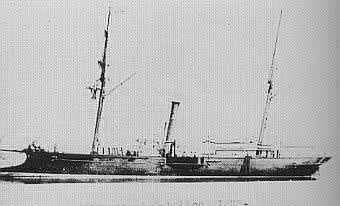


The Minister's plan included to laying the keels four screw propulsion “avisos”, (peculiar Spanish classification that could be considered as 1st class gunboats), intended for repressing contraband and blockading the Carlists seaports. In addition, these boats were to serve as links between the naval forces serving in the Gulf of Biscay, hence their being termed “aviso,” meaning “warning” in English.
Included in the iron-hull avisos would be the future MARQUES DEL DUERO and FERNANDO EL CATOLICO, which, after the end of the 3rd Carlist War in 1876, would be sent to Philippines and Cuba, respectively.
During her maiden voyage from Marseilles, (July 27, 1875), this vessel was sent to San Sebastian Bay, (North of Spain, Basque Country), in order to reinforce the Spanish Fleet in the Bay of Biscay during the Third Civil Carlist War. The 3rd Carlist War ended on February 27th 1876 and on April 5th, 1876 the naval forces operating in the Gulf of Biscay began to be dissolved.
On July 29, 1876, the MARQUÉS DEL DUERO weighed anchor for the Philippines, to be integrated in the South Division of the Spanish Asiatic Fleet at the naval station in Zamboanga. On July 24, 1880, the vessel went to Saigon and Singapore in a formal visit to the kings of Siam and Annam, though the reason for this visit is today a topic of conjecture.
This “aviso” carried out her first action against the “Moros” of Borneo (considered to be pirates by the Spanish) on September 27, 1895 at the same time that she was being re-classified as 3rd class gunboat. She captured several pirate launches. Later, a landing party from the MARQUES DEL DUERO attacked a group of pirates killing 18 men and capturing 30 prisoners among the pirates and Tagalogs.
The MARQUÉS DEL DUERO, when the Battle of Manila Bay occurred, was the
oldest member of Montojo’s squadron. As a
consequence of the American shellfire this boat was destroyed. She was
found to have been hit about five times, including by one 8" shell and
one 6" shell. Her bow gun and one of her side guns were crippled as was
one of her engines. She was scuttled and later burned by a landing party
from the USS PETREL in the closing moments of
the Battle of Cavite/Manila Bay. The vessel was
salvaged by the U. S. Navy and renamed as "P-17". She was scrapped in
1900.
| Classification | First Class gunboat | |
|---|---|---|
| Keel Laid |
January 20, 1875
|
|
| Launched: | May 3,1875 | |
| Hull | Iron | |
| Armament: | One 160 mm muzzleloading bow gun | |
| Two 120 mm Hontoria muzzle-loading guns at the sides | ||
| Contractor: | Forges et Chantiers de la Mediterranée, (La Seyne, Tolon, France). | |
| Length: | 48 m | |
| Beam: | 7.8m | |
| Draft: | ? | |
| Displacement | 550 tons | |
| Complement: | 96 men | |
| Engine Type: | Engines generated 850hp. | |
| Boiler Type: | ? | |
| Speed: | 10-13 knots | |
| Coal bunker capacity: | ? | |
| Normal coal supply: | ? | |
| Armor: | Unarmored | |
| Cost: | ? |
Rear Admiral F. Fernando de Bordeje y Morencos. Crónica de la
Marina Española en el Siglo XIX, 1868 - 1898. Tomo II. Ministerio
de Defensa. Madrid. 1995.
Ellicott, Lt. John M., "Effect of Gun-Fire, battle of Manila Bay, May 1, 1898" Proceedings of the U.S. Naval Institute, 1899, p. 331.
Agustín Ramón Rodríguez González. Política Naval de la Restauración, (1875 – 1898). Editorial San Martín. Madrid. 1988.